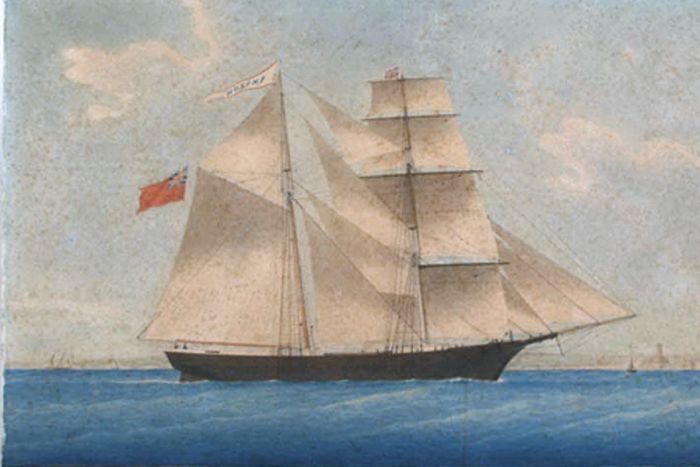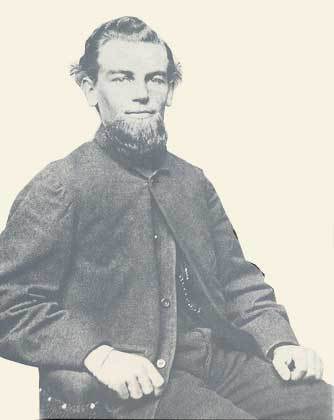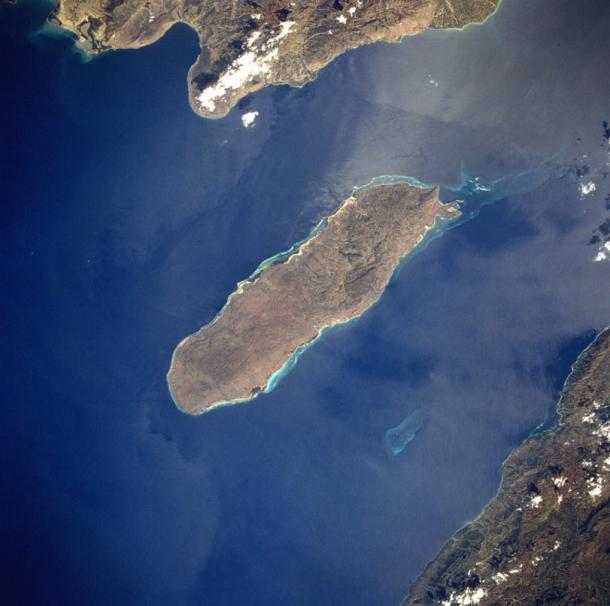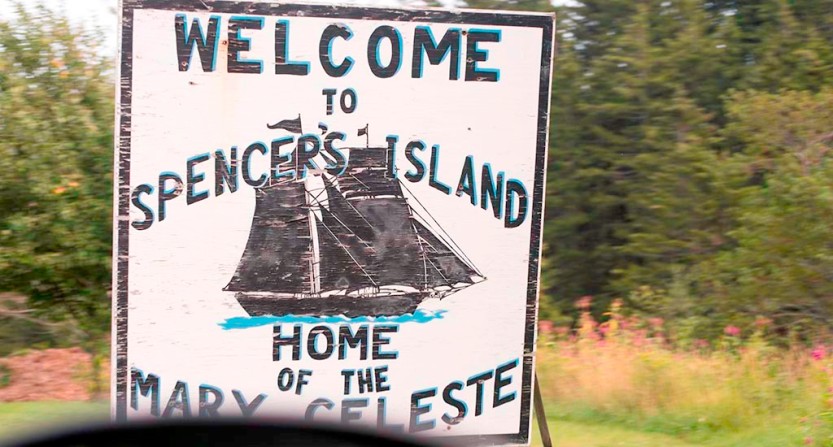“Prepare to abandon ship. Ready the lifeboat at once!”
“Eh? Aye, Captain!”
It sounded so much like Aye Aye, especially with a German accent that the Captain didn’t even realize his order was being questioned! But they were all in a great state of panic and hastily lowered the boat into the Atlantic, while a frantic mother did her best to calm her screaming infant daughter.
People all over the world with an interest in maritime mysteries have wondered for almost 150 years why Captain Benjamin Briggs, a family man, non-drinker and devout Christian with years of respected expertise at the helm of many a ship, gave the order to leave the perfectly seaworthy Mary Celeste on 25 November 1872 and entrust their lives to a tiny lifeboat on the high sea. No captain worth his salt gives this order unless it’s a life threatening emergency and he has no other choice.
Ten days later the Mary Celeste was discovered sailing erratically, sans passengers, by the crew of the Dei Gratia which was also sailing the route from New York to Genoa. No definitive trace of any of those aboard has ever been found to this day.
They spotted her sailing unsteadily towards them when they were about midway between the Azores and the coast of Portugal, several hundred kilometres past the island of Santa Maria.
At first they were wary of sending a boarding party, since it was common for pirates to stay hidden aboard a looted ship and then ambush any ship coming to investigate. So they hung around for a few hours before first mate Oliver Deveau and second mate John Wright ventured aboard.
Once on board they still hesitated awhile before venturing below decks. Put yourself in their position for a moment. Supposing the entire crew had succumbed to a plague and were at that moment decomposing in their cabins?
Deveau and Wright made the following discoveries which they duly reported to Captain Moorhouse:
- Some of the sails were set but some of them were in poor condition or missing altogether. The rigging had also sustained damage but the craft was still quite seaworthy;
- Ropes were hanging loosely over the side of the vessel and some of them were missing;
- The main hatch was securely closed but the fore and lazarette hatches were open with their covers lying beside them;
- The single lifeboat was missing;
- The binnacle housing the ship’s compass had been moved from position and its glass cover was smashed;
- There was about 1.1m (three and a half feet) of water in the hold, which although not ideal is by no means an unusual or alarming amount of water for a ship of her size;
- A makeshift sounding rod for measuring the water level was abandoned on the deck, but there was no sign of the two regular sounding rods which ought to have been aboard;
- The cabins and bedding were quite wet from sea water but were otherwise in fair condition. The captain’s bed was unmade;
- Most of the ship’s papers as well as the captain’s navigational instruments were missing;
- The ship’s last log entry was at 08:00 am on 25 November. No problems were reported. At that point she was about 400km (740 miles) from her discovered position;
- No obvious signs of any fire, explosion or violence were found;
- There were no signs of meal preparation and the galley equipment was neatly stored in place. There was plenty of drinking water and six months worth of provisions, which were in excellent condition;
- The cast iron galley stove had been dislodged from the chocks which kept it moored to the floor during severe conditions. The heavy water cask was also not properly anchored in place;
- The crew’s clothes, rain gear, boots and smoking pipes were still aboard.
Captain Morehouse appointed Deveau and two other experienced seamen to bring the Mary Celeste to Gibraltar while he and the four remaining crew members brought the Dei Gratia in. The trip of about 1100 km (600 nautical miles) would take longer than planned as both ships were now seriously short on manpower.
The Dei Gratia arrived at Gibraltar on 12 November and the Mary Celeste, which had encountered foggy conditions, the following morning.
A salvage hearing began on 17 November to determine the salvage sum to be paid to the crew of Dei Gratia. The Attorney-General of Gibraltar, Frederick Solly Flood conducted proceedings and had a preconceived notion that some foul play had taken place and that the Dei Gratia’s crew may have been involved. Although the Chief Justice, Sir James Cochrane was in charge of proceedings it appears it was Flood who was in charge of leading all evidence (as well as suppositions). There was absolutely no evidence of any suspicious activities to be found yet in the end the Court decided to award a much lower salvage fee than the value of the salvaged ship and cargo merited.
An examination of the Mary Celeste found deep cuts on either side of her bow, which may have been caused by an axe. A number of theories have been advanced to explain these cuts on the bow. Captain Shufeldt of the US Navy, who was called to the witness stand by Horatio Sprague, US Consul, testified that the cuts could quite easily have been caused by the natural action of the waves on the ship’s timbers. Consul Sprague took a great interest in all proceedings and kept the US authorities up to date with numerous cablegrams. He wrote: “This case of the Mary Celeste is startling since it is one of those mysteries which no human ingenuity can penetrate sufficiently to account for the abandonment of the vessel and the disappearance of her master, family, and crew.”
One of the more ridiculous ideas put forward by the inspection team was that the crew of Mary Celeste murdered Briggs and his family in a drunken frenzy and made the marks on the bow to simulate a collision. They omitted to take into account that the contents of the barrels were quite undrinkable.
When the cargo eventually reached Genoa it was finally discovered that nine of the barrels of denatured alcohol were empty. The other 1 692 were intact. The nine empty vats were made of red oak and the remainder from white oak. Red oak has been found to be more porous, thus facilitating vapour leaks.
Let’s go back right to the beginning to examine the history of the Mary Celeste, after which we will make an attempt to find out what may have transpired that fateful day of 25 November 1872.
So where did it all begin?
The Mary Celeste began her life as the Amazon at the lonely outpost of Spencer’s Island, Nova Scotia in late 1860 when her keel was laid. The new vessel was completed on 18 May 1861. She was registered in Parrsboro, Nova Scotia on 10 June 1861. Now at last she was ready for the open seas! The heroine (or villain?) of our story was a two-masted brigantine with an initial tonnage of 198.42.
Several incidents hinted at the vessel attracting bad luck or at least being accident prone. Shortly after registration her first captain, Captain McLellan, who was also a co-owner, fell ill shortly after supervising the loading of her maiden voyage cargo of timber destined for London. His condition worsening, the ship turned back to Spencer’s Island where he died on 19 June.
Captain Parker was the next captain. During his tenure the Mary Celeste had two narrow escapes: on her first voyage to London she collided with some fishing equipment off Eastport, Maine, and some weeks later ran into a brig in the English Channel, which sank.
Under Parker’s command she was put to work in the West Indies and then made a crossing to France in November 1861 where she became the subject of a famous painting.

After a few less eventful years under Captain William Thompson the Amazon was driven onto Cape Breton Island during a storm in October 1867 and so badly damaged that her crew abandoned her as a wreck. But she was bought as a derelict and returned to Nova Scotia. Eventually in 1868 she was sold to an American, Richard W. Haynes and registered as a US ship. Unfortunately the costs of repairing and refurbishing her seem to have bankrupted Haynes because his creditors seized her and she soon came into the possession of a New York consortium, who invested a large sum to improve their investment. She was rechristened Mary Celeste in the hope that her future would turn out better than her shadowy past. Perhaps they wanted to project a softer and less accident-prone image than the warlike name Amazon.
By early 1872 she had been completely overhauled and enlarged at a cost of some $10 000. Now flying the American flag, the reborn ship was 31m (103 feet) wide and 7.8m (25.7 feet) wide, and weighed in at 282.28 tons.
The Voyage of November 1872: Departure for Genoa
Captain Benjamin Briggs arrived in New York on 20 October to supervise the loading of cargo from Pier 50. This cargo was 1701 barrels of poisonous, non-drinkable denatured alcohol, better known as methylated spirits, which is used for a number of industrial and agricultural purposes.

The new captain was aged thirty-seven and hailed from a prominent seafaring family. His wife Sarah and their two year old daughter Sophia Matilda were joining him for the voyage, but his seven year old son would stay home with his grandmother in order to attend school. Mrs Briggs brought her melodeon aboard to play some music, as well as her sewing machine and an array of toys for Sophia.

The captain wrote to his mother on 3 November:
“Our vessel is in beautiful trim and I hope we shall have a fine passage”
He also wrote that he was very happy with his crew, whom he had selected with great care.
Although the Mary Celeste left Pier 50 fully loaded and ready to sail on 5 November, the captain chose to wait for better weather conditions and anchored off Staten Island. This indicates a captain who is level headed and doesn’t take needless risks. The ship finally left Staten Island on 7 November with a crew of seven. They were as follows:
- First mate: Albert G. Richardson
- Second Mate: Andrew Gilling
- Steward / Cook: Edward Head
- General crew: Volkert and Boz Lorenzen, Arian Martens, and Gottlieb Goodschaad, all Germans.
Meanwhile the Dei Gratia under the command of Captain David Morehouse was also preparing to depart for Genoa from Hoboken, NJ with its cargo of petroleum. Captain Morehouse happened to know his fellow seafarer Benjamin Briggs well. The Dei Gratia left just over a week later, on 15 November.
The first two weeks of the Mary Celeste’s voyage passed without notable incident. They were making steady progress of around eight knots and the weather and winds were favourable.
In those days one of the duties of the first mate was to gauge speed by throwing wood chips into the ocean from the bow, and counting the seconds until they drifted past the stern.
The afternoon and night of the 24th November were quite windy and so the crew fastened and furled many of the main sails. They passed the island of Santa Maria, known at the time by the English equivalent of Saint Mary at about 5 a m on the 25th. As the gale was blowing hard from the southwest Captain Briggs had his vessel sail to the north of the island rather than the more direct route to the south of it.
They enjoyed a welcome hot breakfast while in the shelter provided by the nearby island, as it was impossible to prepare hot meals during a gale force wind. After breakfast, the steward put everything away neatly and the Captain returned to bed after ensuring that all was well.
However, soon after this, all hell broke loose and something happened which was so sudden and serious that it led to the Mary Celeste being evacuated and a hasty preparation of the lifeboat.
Speculations and Theories
It didn’t help matters much that the young, not yet famous Arthur Conan Doyle wrote a fictionalized short story based on the incident, which many people accepted as fact, although fiction would become Conan Doyle’s speciality. Using the special licence we writers and poets claim as our princely right he changed the name of the ship to Marie Celeste, as well as numerous other details. A fictitious survivor, an ex-slave named Jephson was the alleged teller of the story.
In 1913 the Strand magazine also published an alleged survivor’s account in which he watched the rest of the crew climb a makeshift platform to watch a swimming contest between some of the crew. The platform fell into the sea and everyone except this one guy were eaten by sharks. The tale was full of inaccuracies, such as calling the captain Griggs and referring to his daughter as seven instead of only two yet many people took it as fact. Captain Briggs would in any event certainly never have allowed such silly and irresponsible behaviour to take place under his command.
Many other wild speculations were made in the months and years following the incident, including piracy, mutiny, alien invasion, a sudden madness on the part of the Captain or crew, giant squid and other peculiar theories which don’t fit in with the facts of the case.
Possible Solutions to the mystery
The Dei Gratia first mate Oliver Deveau was of the opinion that a malfunction of the bilge pumps caused the ship’s crew to evacuate. A waterspout could have struck the ship, damaging the rigging and sails, as well as knocking loose the galley stove and other equipment as well as rupturing the nine barrels of alcohol. The low barometric pressure generated by the spout could have driven water from the bilges up into the pumps, leading the crew to believe the ship had taken on more water than she had, and would sink.
A highly experienced sea captain, Captain David Williams has propounded the theory that the Mary Celeste encountered a seaquake which caused the entire ship to jolt violently and induce a very real fear of an explosion or sinking. The Azores are notorious for frequent seaquakes; however no reports of seaquakes were reported by other ships sailing in the area at the time. So it’s quite possible, although the culprit could equally have been a waterspout or freak wave.
Dr Andrea Sella, a chemical scientist from the UCL believes there was an explosion on board the Mary Celeste, which was caused by a pressure wave from the alcohol and caused a spectacular wave of relatively cool flame accompanied by a jolt, quite harmless but terrifying to observe. It could have been triggered by a spark from two loose barrels rubbing together.
I’m inclined to think such an explosion had a primary cause: a seaquake or waterspout which rocked the boat and caused initial fear to multiply tenfold as this was immediately followed by such an explosion.
Whatever the cause, it was enough to jolt the galley stove and the water tank from their moorings, as well as break the glass cover of the compass. The fumes from the leaked spirits may have affected the crew’s normally sound judgement and caused complete mayhem. Waterspouts like those below are a major maritime hazard:
They simply hacked the lifeboat loose in their hurry. They were too frightened to fetch their belongings. They lashed the lifeboat to the Mary Celeste in case she remained afloat. Unfortunately a freak wave caused the rope to fray. Maybe the lifeboat collided with the ship, not heavily enough to cause damage to the larger craft but to snap the rope and maybe flip the smaller boat, dumping some of them into the sea. The captain’s navigation instruments, essential to guide their lifeboat across the huge expanse of water, were lost to the waves.
They watched helplessly as the empty Mary Celeste, safe and sound and with no sign of an impending fire or blast, moved away from them while they fell further and further behind, at the mercy of the ocean with only a pair of oars. Another freak wave or waterspout, possibly a few hours or even days later, swamped their little boat and they were all drowned.
Five months later (April 1873) five highly decomposed bodies tied to rafts, washed up on the Spanish coast. According to reports one of the bodies was wrapped in an American flag. The Mary Celeste’s flag had been missing. Thus it is quite possible or even likely that these bodies were from the Mary Celeste and that the other five were eaten by marine creatures and never made it to land.
If these bodies were from the Mary Celeste’s lifeboat, maybe they aground on Formigas Bank during a storm and then used timbers from the ruined boat to construct two makeshift rafts.
The End of the Mary Celeste: Plots and Scams
The now notorious Mary Celeste eventually arrived back in the US in September 1873. She had already shattered the reputation of crews from two ships and her own reputation was also rock bottom.
In February 1874 the consortium sold her to a group of New York businessmen at a considerable loss. She was now an albatross around their necks.
The new captain was Captain Edgar Tuthill. He fell ill and died on St Helena during a voyage in February 1879, compounding the ship’s record of bad luck. A few uneventful years passed under the captaincy of Thomas Fleming.
In 1884, Gilman Parker took over as captain. In 1885 he deliberately ran her onto rocks off the Haitian coast as his part in an insurance scam involving the owners, who then claimed a greatly exaggerated amount. Parker defrauded the American consul in Haiti by selling the cargo to him for $500, which he subsequently found to be worthless. Thus the insurance company began a thorough investigation into the whole matter and opened up a can of very wriggly worms.

Captain Parker and his co-conspirators were tried but never convicted due to several technicalities. Three months after the trial Parker died in poverty, his reputation in tatters.
This was the end of the waves for the unfortunate Mary Celeste.

A monument at the place where the Mary Celeste was constructed can be found in Spencer’s Island. Many years later an outdoor cinema, in the shape of the ill-fated ship’s hull, was built in the village.
It is certain that as long as the tides still ebb and flow the Mary Celeste will not be forgotten, as the centrepiece of one of the world’s most enduring maritime mysteries.



Very interesting and well researched, thanks for a great read. 🙂